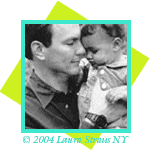|
After a child has been identified
as being at risk of a developmental delay or disorder, what is next for parents
and physicians?
- Physicians: be supportive to the family; be proactive for the child; follow
up.
- Parents: research; use Early Intervention sessions as opportunities to
learn; explore home-based and other therapies; find parent support groups
and other
local resources; and above all, stay involved with your child.
After a physician refers a child to
Early Intervention or
local school district,
and refers the child to appropriate specialists for
diagnostic testing, their
job is not complete. Rather, to ensure the best chances of a child’s success,
this stage is only the beginning of a collaborative effort between pediatricians
and parents. A referral is not enough; follow-up is essential. Parents must contend with an
unfamiliar diagnosis, a new landscape of services and treatments, as well as
a range of complex emotional considerations. Without support, encouragement,
and follow-up, some parents may not be able to move on from “why me?” to “what’s
next?” What can a physician do next?
A physician needs to schedule a follow-up appointment after a screening and referral.
It is crucial to continue to assess not only a child’s developmental progress,
but the family’s progress overall:
- How are they doing?
- Have they noticed any changes in their child?
- Were referrals followed up?
- What sort of program is being established?
- What sort of therapies?
And, after asking these questions of the family, a physician should inquire, “How
can I, as a professional, be more proactive?”
While every family needs encouragement, some families need extra help. Dr. Frances
Glascoe observes, “Certainly many parents are educated or resourceful, have
access to the Web and have the energy and well being to advocate effectively
for their children. But that also means that there are some families that are
less able to do that.” With encouragement and resources, most parents will assume the role of an able
advocate for their children. Dr. Robert Wharton offers an important reminder: “We can’t forget that when
we tell parents that their child has this [developmental] disorder, it’s absolutely
devastating to them. They’ve lost their anticipation of who their child is going
to be. ...And now they’re faced with the fact that they don’t know what to anticipate,
and we often don’t either. And so, it’s forming a contract with them to say,
’OK, it’s an uncertain future. We’re going to help you. We’ll help your child,
but we’re going to walk through this uncertainty together.’ What can a parent do next?
Once a child has a diagnosis, it may seem like the question marks about a child’s
development have been removed, and substituted by an exclamation point. “What
is wrong?” may become “Autism!” But parents have to move beyond
the name and begin to learn the rules of the waiting game. Many programs and
specialists have long waiting lists, and progress often seems slow; however,
parents can do many things in the meantime.
- Use this time as an opportunity to study about
the disorder. Read, research,
and re-invigorate.
- Start your research with Autism Navigator, Autism Society, and Autism Speaks
- Contact the Autism Society of America (ASA) to start your research.
- If your child is receiving services from Early
Intervention, use those sessions as opportunities to learn. How is the specialist engaging the child?
What sort
of activities are they doing, and why? What might you be able to do at home?
- Explore home-based therapies that involve parent
participation, such as “Floortime” (ICDL).
- Seek speech/language, occupational, physical, or other
appropriate therapies. Often, individual therapies (as opposed to programs, centers, or some well-established
specialists) have shorter waiting lists.
- Find a local parent support group. You don’t have to “share” if
you don’t want to; it may be helpful just to listen. Experienced parents
can give
you resources, guidance, camaraderie, and above all, perspective. Many parent
groups also host training sessions, which enable you to build upon your natural
skills.
- Above all, become more involved with your child. While you may not be able
to “cure” your child, your direct participation can play a critical
role in promoting your child’s healthy neurological development. Get down
on the floor and play: blow bubbles; try a tickle; or, just sing and dance.
Children
with developmental disorders, like all children, need loving and engaged
caregivers to open their minds and hearts to the world.
As Dr. Karen Levine, a developmental psychologist, observes: “Parents
become the best therapists in many ways. They’re the ones who have the strongest
connections
to the children. And once parents are able to see how much they can connect and
help their child develop, I think that’s the most therapeutic moment for a parent
who is grieving...It’s like, “Oh, I can have an influence. I can help my child
develop. I can bring my child out’.”
What can a concerned friend or family member do next?
“Knowing what to say or how to
help parents who have recently had a child receive an autism diagnosis can
be tricky business. Emotions
are running high for all
involved. Do you try and cheer the parents up? Do you offer your condolences?
Are there right and wrong things to say?”
Back to top
Next page =>
|




